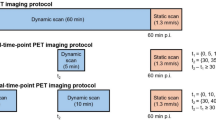Abstract
The GE/CGR Neurocam is a triple-headed single photon emission tomography (SPET) system dedicated to multi-slice brain tomography. We have assessed its physical performance in terms of sensitivity and resolution, and its clinical efficacy in comparison with a modern, single rotating gamma-camera (GE 400XCT). Using a water-filled cylinder containing technetium-99m, the tomographic volume sensitivity of the Neurocam was 30.0 and 50.7 kcps/MBq · ml · cm for the high-resolution (HR) and general-purpose (GP) collimators, respectively; the corresponding values for the single rotating camera were 7.6 and 12.8 kcps/(MBq/ml)/cm. Tomographic resolution was measured in air and in water. In air, the Neurocam resolution at the cente of the field-of-view (FOV) is 9.0 and 10.7 mm full width at half-maximum (FWHM) with the HR and GP collimators, respectively, and is isotropic in the three orthogonal planes; the resolution of the GE 400XCT with 13 cm radius of rotation is 10.3 and 11.7 mm, respectively. For the Neurocam with the HR collimator, the transaxial FWHM values in water were 9.7 mm at the centre and 9.5 mm radial (6.6 mm tangential) at 8 cm from the centre. The physical characteristics of the Neurocam enable the routine acquisition of brain perfusion data with technetium-99m hexamethyl-propylene amine oxime (99mTc-HMPAO) in about 14 min, yielding better image quality than with a single rotating camera in 40 min.
Similar content being viewed by others
References
American Association of Physicists in Medicine (1987) Rotating scintillation camera SPELT acceptance testing and quality control. AAPM report no. 22, New York
Budinger TF (1990) Advances in emission tomography: quo vadis? J Nucl Med 31:628–631
Data Spectrum (1990) 3-D Hoffman brain phantom: user manual. Data Spectrum Corporation, Chapel Hill
Fahey FH (1991) Dedicated cameras for SPELT. SNM Computer and Instrumentation Council Newsletter 9 (2)
Genna S, Smith AP (1988) The development of ASPECT, an annular single crystal brain camera for high efficiency SPECT. IEEE Trans Nucl Sci NS-35:654–658
George MS, Ring HA, Costa DC, Ell PJ, Kouris K, Jarritt PH (1991) Neuroactivation and neuroimaging with SPET. Springer, Berlin Heidelberg New York
Gilland DR, Tsui BMW, McCartney WH, Perry JR, Berg J (1988) Determination of the optimum filter function for SPELT imaging. J Nucl Med 29:643–650
Hoffman EJ, Cutler PD, Digby WM, Mazziota JC (1990) 3-D phantom to simulate cerebral blood flow and metabolic images for PET. IEEE Trans Nucl Sci 37:616–620
Holman BL, Carvalho PA, Zimmerman RE, Johnson KA, Tumeh SS, Smith AW, Genna S (1990) Brain perfusion SPELT using an annular single crystal camera: initial clinical experience. J Nucl Med 31:1456–1461
Ichihara T (1990) Development of a high resolution SPELT system. Toshiba Med Rev 33:29–35
Jaszczak RJ, Chang LT, Murphy PH (1979) Single photon emission computed tomography using multi-slice fan beam collimators. IEEE Trans Nucl Sci 26:610–618
Keyes JW, Fahey FH, Harkness BA (1990) Tips for high quality SPECT. SNM Computer and Instrumentation Council Newsletter
Kimura K, Hashikawa K, Etani H, et al. (1990) A new apparatus for brain imaging: a four-head rotating gamma camera single-photon emission computed tomograph. J Nucl Med 31: 603–609
Kouris K, Elgazzar A, Affana R, et al. (1990) Methodology and performance assessment of zoom SPECT. J Nucl Med Technol 18:198–203
Larsson SA, Bergstrand G, Bergstedt HF, et al. (1984) A specially cut-off gamma camera for high spatial resolution SPECT of the head. J Nucl Med 25:1023–1030
Lim CB, Gottschalk S, Walker R, et al. (1985) Triangular SPECT system for 3-D total organ volume imaging: design concept and preliminary results. IEEE Trans Nucl Sci 32:741–747
Lim CB, Walker R, Pinkstaff C, et al. (1986) Triangular SPECT system for 3-D total organ volume imaging: performance results and dynamic imaging capability. IEEE Trans Nucl Sci 33:501–504
Links JM, Jeremy RW, Dyer SM, Frank TL, Becker LC (1990) Wiener filtering improves quantification of regional myocardial perfusion with thallium-201 SPECT. J Nucl Med 31:1230–1236
Mueller SP, Polak JF, Kijewski MF, et al. (1986) Collimator selection for SPELT brain imaging: the advantage of high resolution. J Nucl Med 27:1729–1738
NEMA NU 1 (1986) Performance measurements of scintillation cameras. National Electrical Manufacturers Association, Washington DC
Tsui BMW, Gullberg GT (1990) The geometric transfer function for cone and fan beam collimators. Phys Med Biol 35:81–93
Tsui BMW, Gullberg GT, Edgerton ER, et al. (1986) Design and clinical utility of a fan beam collimator for SPELT imaging of the head. J Nucl Med 27:810–819
Author information
Authors and Affiliations
Additional information
Offprint requests to: K. Kouris
Rights and permissions
About this article
Cite this article
Kouris, K., Jarritt, P.H., Costa, D.C. et al. Physical assessment of the GE/CGR Neurocam and comparison with a single rotating gamma-camera. Eur J Nucl Med 19, 236–242 (1992). https://doi.org/10.1007/BF00175135
Received:
Revised:
Issue Date:
DOI: https://doi.org/10.1007/BF00175135




